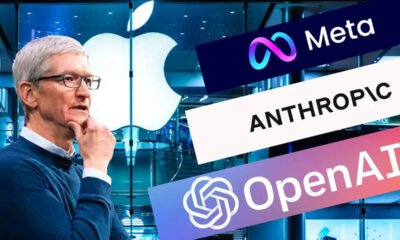Business
Amazon-backed AI company Anthropic updates terms of service to ban sales Chinese companies, cites threat to national security

OpenAI rival Anthropic has updated its terms of service prohibiting sales of its AI platform Claude services to companies in China, Russia, North Korea and other regions “due to legal, regulatory, and security risks.” In an official blog, the AI company backed by Amazon said that firms based in authoritarian countries like China may be forced by law to share data, work with intelligence agencies, or take other steps that could pose national security risks. “These requirements make it difficult for companies to resist these pressures regardless of where they operate or of the personal preferences of the individuals at those companies,” it added.Sharing the blog post, the company said “Anthropic’s Terms of Service prohibit use of our services in certain regions due to legal, regulatory, and security risks. However, companies from these restricted regions—including adversarial nations like China—continue accessing our services in various ways, such as through subsidiaries incorporated in other countries.”In the blog post, Anthropic said that it is going a step further in an update to its terms of service. “This update prohibits companies or organizations whose ownership structures subject them to control from jurisdictions where our products are not permitted, like China, regardless of where they operate,” the company said.
Poll
Should AI tools be allowed to operate in countries with strict data-sharing laws?
Anthropic settles copyright lawsuit with US authors
Anthropic recently reached settlement in a high-profile class action lawsuit filed by a group of US authors. For those unaware, a group of US authors accused the company of using their copyrighted works without their permission or compensation to train its AI models. The terms of the settlement were not disclosed to the public, but agreement makes a significant moment in the ongoing battle between AI developers and creative professionals.Originally filed in 2024, the lawsuit alleged that Anthropic scraped and ingested thousands of books which included non-fiction, fiction and academic text books to train its AI system Claude without any authorisation. The class-action lawsuit filed included some prominent authors and was also backed by the Authors Guild. The Authors Guild organisation has been quite vocal in demanding stronger protections for writers in the growing AI era.
Business
Imperfect AI creates more editing business opportunities – DIGITIMES Asia
Business
OpenAI forecasts $115 billion business spend on AI rollout by 2029

OpenAI has elevated its cash burn forecast this year through 2029 to a total of $115 billion. The company’s recent cash burn expectation is also $80 billion higher than it previously projected.
According to a report by The Information, the surge in cash burn for OpenAI comes at a time when it’s ramping up spending to power the artificial intelligence behind its popular ChatGPT chatbot. The tech firm has also become one of the world’s biggest renters of cloud services.
OpenAI plans to develop its chips and data center facilities
The source revealed that the AI company expects to burn over $8 billion this year. OpenAI had forecasted early in the year that it would only burn around $1.5 billion.
According to the report, OpenAI doubled its cash burn expectations for 2026 to more than $17 billion, surpassing its previous forecast of $10 billion. The firm also projects a $35 billion cash burn in 2027 and $45 billion in 2028.
The FT also disclosed on Thursday that the Silicon Valley startup plans to develop its data center server chips and facilities to power its technology. According to the report, the initiative aims to control the tech company’s surging operational costs.
The firm relies on substantial computing power to train and run its systems. The company’s CEO, Sam Altman, has also advocated the need for increased computing power to accommodate the growing demand for AI products such as ChatGPT.
Deloitte’s 2025 AI infrastructure Survey revealed that the energy demands of AI are straining traditional power grids. According to the study, 79% of executives anticipate increased power demand through the next decade, with grid stress emerging as a top challenge.
The source added that U.S. semiconductor giant Broadcom will partner with OpenAI to produce the first set of chips and start shipping them by next year. Also, OpenAI allegedly plans to use the chips internally rather than selling them for external clients.
Broadcom’s CEO, Hock Tan, hinted the company had partnered with an undisclosed customer that committed to $10 billion in orders. During a call with analysts, he revealed the firm had secured a fourth customer to boost its custom AI chip division. Tan stated the collaboration with OpenAI has enhanced its growth outlook for fiscal 2026 by generating immediate and substantial demand.
OpenAI partners with Broadcom to produce chips
OpenAI also partnered with Broadcom and Taiwan Semiconductor Manufacturing Co. (TSMC) nearly a year ago to develop its first in-house chip. The firm was also planning to add AMD chips alongside Nvidia chips to meet its surging infrastructure demands.
OpenAI revealed in February plans to reduce its reliance on Nvidia’s chips. The firm said it will finalize the design of the new chip in the next few months and then send it to TSMC for fabrication. OpenAI’s initiative also builds on its ambitious plans to increase its semiconductor production at the Taiwanese company next year.
According to the report, OpenAI hopes to use the new chips to strengthen its negotiating leverage with other chip suppliers, including Nvidia. The company’s in-house team, led by Richard Ho, will design the chip to produce advanced processors with broader capabilities with each new iteration.
OpenAI collaborated with Oracle in July to launch a 4.5-gigawatt data center. The initiative also complements the firm’s $500 billion Stargate project, including investments from Japanese firm SoftBank Group. The tech giant has also collaborated with Google Cloud to supply computing capacity.
Get $50 free to trade crypto when you sign up to Bybit now
Business
Need to Rank in AI Overviews? These SEO Agency Specializes in them

Search is changing. AI-generated answers now appear in nearly half of all queries, creating new conditions for brand visibility. This affects how people find and trust brands online. Agencies with a narrow focus and unique capabilities have stepped in to meet this need. Among them, Growing Search manages both classical and AI-driven search with all work in-house. Their approach uses internal tools to track, analyze, and improve citations and sentiment across search platforms powered by artificial intelligence, such as ChatGPT and Perplexity. This article examines the tactics, technology, and reported impact of Growing Search in the context of this new search environment.
AI Overviews: A New Standard for Brand Visibility
Recent data shows that AI-generated summaries now appear in over 42% of all search results as of 2025. These AI Overviews usually display above regular listings and paid ads. The impact is straightforward. When a brand appears in these boxes, it commands user attention at the first step of a search. The positioning affects both user awareness and perceived authority.
Users often interact with AI-generated content before considering the rest of the results page. As a result, the context and credibility of source content have become essential. Brands must be discoverable and present information in a way that artificial intelligence can interpret as both trustworthy and relevant.
Unique Challenges in AI Search
AI search systems, including those behind Gemini, ChatGPT, and Perplexity, work differently from traditional engines. They scan many sources but look for signals beyond repeating keywords. They prefer content that is context-aware, semantically precise, and written by authorities in the subject. This approach changes what is needed to earn citations.
Old methods, which relied heavily on repeating high-traffic keywords, now hold less value. Instead, there are new requirements:
- Content must match the detailed intent of the user’s query, not only broad or superficial keyword strings.
- The writing must signal expertise and context that AI can detect and validate.
- Brand mentions and topic clusters, called entities, must be visible and consistent to help artificial intelligence select credible sources.
Citations in AI answers have grown more valuable. When users see these automated answers, the sources cited enjoy increased trust, even if most people do not click through to the original page. This influence shapes user decisions and can drive tangible results, such as more inquiries or conversions.
How Growing Search Approaches AI-Driven SEO
Growing Search focuses on both established and AI-powered search platforms. They manage audits, keyword research, content structuring, and link building. Their added strength is tracking brand mentions and sentiment within artificial intelligence tools, not only on classic search engines.
With everything handled in-house, the agency ensures accuracy and keeps processes efficient. They do not depend on third parties to handle data or make changes. This direct control is reported to result in faster responses and stronger data privacy.
Proprietary Tools: StakeView and BrandLens
Growing Search’s approach centers on two internal analytics platforms: StakeView and BrandLens.
StakeView gives brands ongoing analysis of their organic market share against competitors. It shows results for both standard search engines and AI answer engines. This lets clients see shifts in their presence and make quick decisions if needed.
BrandLens tracks sentiment and citation occurrences for a brand in AI-powered platforms. The software measures both the volume of mentions and the tone. It shows whether a brand is being named as an authority, described in a neutral voice, or mentioned with negative intent. This feedback is vital because search engines and users both react to subtle shifts in brand reputation triggered by AI answer summaries.
Industry commentary points to this kind of tracking as a necessity. As AI Overviews become more common, exposure in these features offers advantages even for those not at the top of traditional ranking pages. If a brand signals high expertise and authority, it may be named by the artificial intelligence, even without ranking high in the organic results.
In-House Analytics and Direct Control
Running all operations and tooling internally gives Growing Search certain benefits. The company can update its analytics to adapt to changes in AI algorithms quickly. When AI search behavior shifts, there are no delays caused by waiting for outside vendors. This keeps its clients aligned with the latest ranking practices.
By owning all data pipelines and analytics platforms, Growing Search also reduces risk related to data privacy and quality. Insights from StakeView and BrandLens can be passed quickly to the consulting or editorial teams.
Recent industry studies confirm that agencies using custom tools report better tracking of AI citations and sentiment. This allows campaigns to shift as needed, sometimes before competitor actions or algorithmic updates would otherwise affect visibility.
Performance in Traditional and AI Search
Classical search engines still send many users to brand websites, but new data shows accelerated gains for those featured in AI answers. Quickly summarized AI Overviews cater to users looking for direct, authoritative responses. Brands mentioned or cited in these summaries attract more inquiries and an improved reputation.
Examples from ongoing research:
- Sites displayed in AI Overviews see upwards of 30% more brand mentions and a reported 20% increase in positive sentiment from users.
- Market share in these answer engines may be higher for brands with well-signaled trust markers, even over established competitors with better traditional ranks.
- Tools that track live citations and sentiment enable brands to respond to shifts within days or even hours, rather than weeks, as was often the case with older systems.
Why Sentiment and Citations Now Matter Most
AI-driven search engines have updated how they measure and rank authority. Recognition of entities and positive context is now a ranking factor. More weight is put on the sentiment AI models detect within content, and the strength of authority signals a brand projects.
Unlike older analytic tools that only tracked clicks or position in rank, BrandLens records both citation frequency and how the brand is discussed in AI answers. This approach tracks fine details. For example, a drop in positive mentions can be seen quickly. The client can respond immediately by adjusting how their brand or content appears. This rapid response helps manage risk during sensitive launches, events, or crises.
Evidence and Reported Results
Some results published by brands using Growing Search’s proprietary toolset show the effect of this detail-oriented approach:
- Brand mentions in AI Overviews can rise by 18% to 35% within six months once targeted content and authority adjustments are implemented.
- Early alerts show competitor names or products entering AI answer boxes before they reach traditional search rankings. This helps preemptively adjust marketing efforts.
- When sentiment in AI answers shifts negative or neutral, corrective steps can be applied and tracked for impact, supporting brand reputation at critical times.
Several reports from the first part of 2025 mark this approach as outperforming typical search optimization alone. Agencies not focused on tracking live AI mentions and sentiment are reported to miss emerging opportunities and suffer a loss of market share, especially now that over four in ten initial search interactions occur within AI-powered boxes.
What Brands Should Do Now
Brands that want reliable performance have clear steps, as seen from both case data and expert commentary:
- Use in-house analytics to monitor live share across regular and AI-driven search. Delayed or sampled data is less useful once AI results are updated frequently.
- Review and adjust internal content and authority markers. Ensure that expert signals and entities are consistently projected.
- Invest in tools that provide both quantitative insights (such as mention count) and qualitative feedback (such as sentiment) so that reputational risk can be managed directly.
- Focus on direct execution and internal expertise. Owning the data and workflow allows for prompt action as algorithms and platforms update their requirements.
Summary of Industry Findings
Agencies working with both search systems and artificial intelligence tools, supported by exclusive in-house analytics, are now driving the most measurable gains for brands. Platforms like StakeView and BrandLens provide timely, specific feedback. This helps manage brand presence in new AI Overviews as well as classic organic search. In-house execution remains essential for keeping pace with ongoing shifts in how answers are created and displayed.
Growing Search is an example of this approach. All work, from research to technical implementation, is handled by its own teams. The result is direct feedback, faster corrective cycles, and verifiable improvements in visibility and reputation.
As artificial intelligence systems mediate an increasing share of user discovery, brands need to focus on facts, measurement, and timely action. Agencies prepared for this with the right expertise and technology will keep their clients positioned at key points in the search journey.
-

 Business1 week ago
Business1 week agoThe Guardian view on Trump and the Fed: independence is no substitute for accountability | Editorial
-
Tools & Platforms4 weeks ago
Building Trust in Military AI Starts with Opening the Black Box – War on the Rocks
-

 Ethics & Policy1 month ago
Ethics & Policy1 month agoSDAIA Supports Saudi Arabia’s Leadership in Shaping Global AI Ethics, Policy, and Research – وكالة الأنباء السعودية
-

 Events & Conferences4 months ago
Events & Conferences4 months agoJourney to 1000 models: Scaling Instagram’s recommendation system
-

 Jobs & Careers2 months ago
Jobs & Careers2 months agoMumbai-based Perplexity Alternative Has 60k+ Users Without Funding
-

 Education2 months ago
Education2 months agoVEX Robotics launches AI-powered classroom robotics system
-

 Podcasts & Talks2 months ago
Podcasts & Talks2 months agoHappy 4th of July! 🎆 Made with Veo 3 in Gemini
-

 Funding & Business2 months ago
Funding & Business2 months agoKayak and Expedia race to build AI travel agents that turn social posts into itineraries
-

 Education2 months ago
Education2 months agoMacron says UK and France have duty to tackle illegal migration ‘with humanity, solidarity and firmness’ – UK politics live | Politics
-

 Podcasts & Talks2 months ago
Podcasts & Talks2 months agoOpenAI 🤝 @teamganassi






















